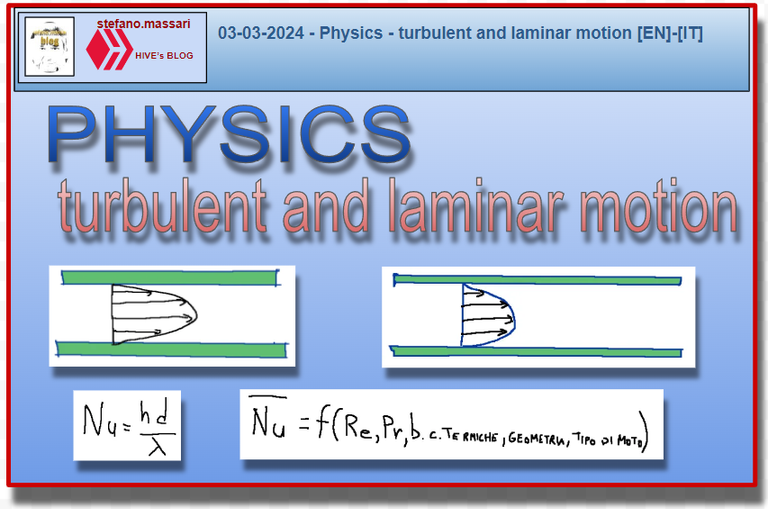03-03-2024 - Fisica - moto turbolento e laminare [EN]-[IT]

~~~ La versione in italiano inizia subito dopo la versione in inglese ~~~
ENGLISH
03-03-2024 - Physics - turbulent and laminar motion [EN]-[IT]
Basic concepts
Thermodynamics is a very broad branch of physics and it is good to always keep some basic concepts in mind. Below I mention some of them.
Conduction
-Slab
From the study of the conduction of a plate made up of two different materials 1 and 2 we can deduce that the percentage of temperature lost in degrees when passing through the thickness of material 1 is equal to the resistivity of material 1 compared to the resistivity of the entire plate.
-Masonry
In a masonry with an air chamber, the air contained in it will cause an exchange of energy between the walls by convection and radiation.
-Plate touched by fluids
Considering a plate touched on both sides by different and moving fluids, we can say that if the speeds of the fluids are very high, the convective resistance tends to zero and the temperature of the fluid coincides with that of the surface of the plate.
turbulent and laminar motion
In forced convection we have laminar motion and turbulent motion
laminar motion is synonymous with stable equilibrium, in which disturbances tend to be absorbed
Turbulent motion is of unstable equilibrium with stronger frictional stresses
Velocity profile in a duct in which there is laminar motion

Velocity profile in a duct in which there is turbulent motion

Nusselt number
In this case we must remember the Nusselt number, which is the dimensionless group that expresses the ratio between the heat flow exchanged by convection and the heat flow exchanged by conduction.
The Nusselt number can be expressed as follows:

Where:
h = heat exchange coefficient
d = characteristic length in m (usually equal to the equivalent diameter of the duct)
λ = thermal conductivity
In forced convection the Nusselt number can be rewritten as follows

Conclusions
In the case of motion in a cylindrical conduit, in a turbulent regime the fluid moves in a disorderly manner. The average advance speed is almost constant over the section.
In laminar motion, however, the trajectories are rectilinear and the velocity profile is parabolic.
Turbulent flow differs from laminar flow in that vortical structures are present within it.
Request
I happened to try to calculate the speed of the water in some pipes and when we are faced with turbulent motions things get complicated. Have you ever performed calculations on the flow of a fluid? I mean on the flow rate, the speed or its pressure drops?

03-03-2024 - Fisica - moto turbolento e laminare [EN]-[IT]
Concetti base
La termodinamica è un ramo della fisica molto ampio e alcuni concetti base è bene tenerli sempre in mente. Qui di seguito ne menziono qualcuno.
Conduzione
-Lastra
Dallo studio della conduzione di una lastra costituita da due materiali diversi 1 e 2 possiamo dedurre che la percentuale di temperatura persa in gradi quando si attraversa lo spessore del materiale 1 è pari alla resistività del materiale 1 rispetto alla resistività dell'intera lastra.
-Muratura
In una muratura con camera d’aria, l’aria in essa contenuta provocherà uno scambio di energia tra le pareti per convezione e per irraggiamento.
-Lastra lambita da fluidi
Considerando una lastra lambita sui due lati da fluidi diversi e in movimento, possiamo dire che se le velocità dei fluidi sono molto alte, le resistenze convettive tendono a zero e la temperatura del fluido coincide con quella della superficie della lastra.
moto turbolento e laminare
Nella convezione forzata abbiamo il moto laminare ed il moto turbolento
il moto laminare è sinonimo di equilibrio stabile, in cui i disturbi tendono ad essere assorbiti
Il moto turbolento è di equilibrio instabile con sforzi di attrito più forti
Profilo di velocità in un condotto in cui c’è moto laminare

Profilo di velocità in un condotto in cui c’è moto turbolento

numero di Nusselt
In questo caso dobbiamo ricordare il numero di Nusselt, che è il gruppo adimensionale che esprime il rapporto tra il flusso di calore scambiato per convezione e il flusso di calore scambiato per conduzione.
Il numero di Nusselt può essere espresso come segue:

dove:
h = coefficiente di scambio termico
d = lunghezza caratteristica in m (solitamente è pari al diametro equivalente del condotto)
λ = conduttività termica
Nella la convezione forzata il numero di Nusselt può essere riscritto come segue

Conclusioni
Nel caso di moto in un condotto cilindrico, in regime turbolento il fluido si muove in maniera disordinata. La velocità media di avanzamento è pressoché costante sulla sezione.
Nel moto laminare invece le traiettorie sono rettilinee ed il profilo di velocità parabolico.
Il flusso turbolento differisce dal flusso laminare laminare in quanto al suo interno sono presenti strutture vorticose.
Domanda
A me è capitato di provare a calcolare la velocità dell’acqua in alcuni condotti e quando siamo di fronte a moti turbolenti le cose si complicano. Avete mai eseguito dei calcoli sul flusso di un fluido? Intendo sulla portata, la velocità o le sue perdite di carico?
THE END
Physics is one of the subjects the I don't really like during my school time.
so I don't really have the answer for your question, but it is an interesting read for sure.
!LUV !PIZZA
Thanks for stopping by. I have written several things about physics. Let's say that this series of posts that I have made are dedicated to thermodynamics and these will be the last posts dedicated to this topic. So they are certainly among the most complex
$PIZZA slices delivered:
@ekavieka(3/5) tipped @stefano.massari
This makes me feel like you know every damn topic in physics, lol
You’re just too good
Keep it up!
Thanks for your kind words, But this is absolutely not true, in this series of articles I mainly talk about topics that are addressed by studying thermodynamics. Physics is much broader. Let's say that the thermodynamics part is the one I know best. However, the only thing you need to remember from this article is that turbulent motion is synonymous with unstable equilibrium (stronger frictional forces), while laminar motion is synonymous with stable equilibrium
Thank you for your constant dedication in always making sure the lectures are easy to understand
Thank you for stopping by. Let's put aside all the various formulas that can even confuse or not be completely understandable. The most important thing that is written in this article is the difference between turbulent flow and laminar flow. Turbulent motion is synonymous with unstable equilibrium, laminar motion is synonymous with stable equilibrium, in which disturbances tend to be absorbed.
@tipu curate
Upvoted 👌 (Mana: 25/45) Liquid rewards.
Grazie MAD per il tipu, ammetto che mi aspettavo una perdita di followers più consistente dopo questa serie di post sulla termodinamica, invece tutto sommato non è andata male.
!discovery 25
Grazie Liberty per essere sempre presente. Aggiungo una cosa a riguardo dell'articolo qui prodotto. Mettiamo da parte tutte le varie formule che possono anche confondere o non essere del tutto comprensibili. La cosa più importante che è scritta in questo articolo è la differenza tra moto turbolento e moto laminare. Il moto turbolento è sinonimo di equilibrio instabile, il moto laminare è sinonimo di equilibrio stabile, in cui i disturbi tendono ad essere assorbiti.
This post was shared and voted inside the discord by the curators team of discovery-it
Join our Community and follow our Curation Trail
Discovery-it is also a Witness, vote for us here
Delegate to us for passive income. Check our 80% fee-back Program
No, di nuovo la stessa risposta, ma sono onesto :)
L'unica cosa da ricordare di questo articolo è la differenza tra moto turbolento e moto laminare. Questa differenza si può riassumere in breve come segue:
Il moto laminare è sinonimo di equilibrio stabile, in cui i disturbi tendono ad essere assorbiti; il moto
turbolento è invece il contrario, è sinonimo di equilibrio instabile (sforzi di attrito più forti).